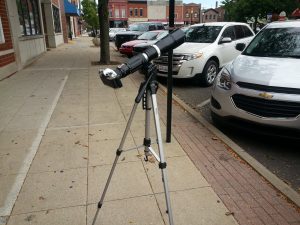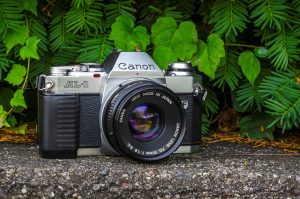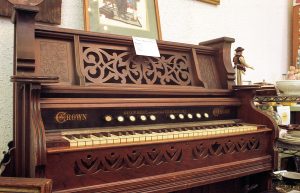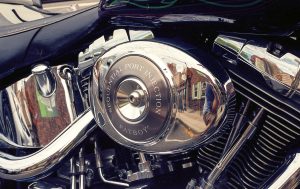This is a Canon AL-1 35mm Single Lens Reflex camera which was first introduced in March 1982. It was the last in the Canon A-series which started with the AE-1 in 1976, and was one of Canon’s last cameras to use their aging FD lens mount. The AL-1’s signature feature was a very innovative focus confirmation system which allowed photographers to use manual focus lenses and see LED indicators in the viewfinder that would help them get perfect focus. Although the AL-1 was not a true auto focus camera, it served as a bridge between existing manual focus only cameras, and a true autofocus SLR. Combined with aperture priority auto exposure, the AL-1 was a pretty advanced camera that simplified exposure and focus composition for novice photographers.
Film Type: 135 (35mm)
Lenses: 50mm f/1.8 + others
Lens Mount: Canon FD Breech / Bayonet Mount
Focus: 3 feet to Infinity
Viewfinder: Fixed SLR Prism w/ Aperture Scale
Shutter: Focal Plane Cloth
Speeds (Auto): 2 – 1/1000 seconds stepless
Speeds (Manual): B, 1/15 – 1/1000 seconds
Exposure Meter: TTL Center Weighted Silicon Photo Cell with Aperture Priority Auto Exposure
Battery: 2 x 1.5v AAA Batteries
Flash Mount: Hotshoe and PC MX Sync
Weight (body only): 489 grams
Manual: http://www.cameramanuals.org/canon_pdf/canon_al-1.pdf

Camera of the Dead Update
This is the second time I’ll be reviewing the Canon AL-1, the first was in my 3rd edition of the Cameras of the Dead series where I talk about dead cameras that for one reason or another, will never shoot another photograph again.
The Canon AL-1 has the distinction of having one of the worst designed battery compartments of any camera ever made. The issue is that the door that holds the batteries in place almost always breaks. Making matters worse, a metal plate that bridges the two AAA batteries together almost always falls out, meaning the camera can’t get any power. Being fully electronic, when this happens there is no way to use the camera, not even at a single speed like other electronic shutter cameras like the Nikon EM or Yashica Electro can.
Amazingly, I was able to find a working, unmolested AL-1 which allowed me to use this camera as it was intended. I thought the experience was worth sharing with you in a second review. Most of the text below is a duplicate of that first review, but I edited out all references to the camera not working, and added my thoughts about what it was like to use it.
History

The Canon A-series remains one of the most popular and successful lineups of cameras ever made. Millions of AE-1s were sold in the 10+ years they were made, and many of them are still used widely today. Despite the success of the AE-1, I never found myself drawn to them and despite owning at least 4 of them over the years, I never enjoyed them enough to keep one, and as a result I’ve resold every one that has come my way. (Edit: This is a lie, I still have one…don’t tell anybody!)
There are two primary reasons I am not a fan of the AE-1. The first is that the camera requires power to work. It is a completely electronic camera that doesn’t do anything if the battery dies. While that’s not exactly unique to the AE-1 as there have been many other SLRs that suffer the same fate with a dead battery, it doesn’t have to be this way. All Nikon SLRs made during the production run of the AE-1 are still usable with at least one speed, with a dead battery, even the lowly Nikon EM.
My second complaint with the AE-1 is that it’s auto exposure system is shutter priority which means you manually control the shutter speeds and the camera selects an appropriate f/stop based on the available light. There are some advantages to shutter priority like when shooting sports or other fast moving objects, and I can certainly understand that for a beginner trying to explain shutter speeds is a lot easier than aperture f-stops, but I find that in my style of photography I prefer aperture priority much more.

While I acknowledge that the AE-1 was a generally good camera that had a large selection of excellent Canon FD mount lenses, I have never found myself drawn to it, or any Canon A-series for that matter. Then I discovered the Canon AV-1.
The Canon AV-1 is a simplified version of the AE-1 that is also completely electronic, but it supports aperture priority auto exposure. Although it lacks any sort of full manual control, the AV-1 is physically smaller and weighs less, and has a better designed battery compartment than the AE-1, yet it supports all the same lenses. The Canon AV-1 was one of the earlier cameras I reviewed on this site, and since that post was first published back in May 2015, I’ve taken it out numerous times since then. I find the compact and lightweight feel of the body, with the bright viewfinder, and awesome Canon lenses to be an excellent combination. If I want a mechanical, fully manual camera, I just take something else, but for those family trips to the zoo where I don’t want to think, the AV-1 is a great choice.
Then one day, I learned of yet another Canon SLR with aperture priority auto exposure, but it also had a unique focus assist feature. It even offered more manual speeds than the AV-1’s single 1/60 manual speed. I thought, WOW, this could be the perfect Canon SLR! I could still use my Canon FD mount lenses, and would still have aperture priority auto exposure, but the camera could also help me judge accurate focus, just like my Nikon D7000 DSLR does when I use manual focus lenses! I was sold, until I started to look for one.

The Canon AL-1 isn’t an auto focus camera in the traditional sense. It is still a manual focus camera, but it uses an array of three sensors that act as sort of an electronic rangefinder to determine whether something is correctly in focus or not. Canon called this the “QF” or “Quick Focus” system. The QF system was advanced for it’s day and worked quite well. Although I have not found any evidence of this, I would guess that the research and development needed while making the AL-1 meant that the camera was sold as a loss. I have to imagine that Canon used this model as a test platform while developing their eventual auto focus platform which would debut with the EOS 650 in 1987.

The Photography in Malaysia “MIR” site has an excellent write up of how the Quick Focus system worked in the AL-1. I won’t duplicate too much here, but if you are interested, I highly recommend reading their article. The gist is that by having a reflex mirror with an intricate semi-transparent pattern, some of the light from the lens would pass through the main reflex mirror and be reflected onto a second “sub-mirror” that pointed to 3 CCD line sensors on the bottom of the mirror box. You can see both the semi-transparent pattern, and the sub-mirror (inset) in the image to the right.
These sensors would measure whether or not the image passing through the lens was in focus or not. Using 3 LEDs visible in the viewfinder, two left and right arrows would indicate if the image is over or under focused, and a third green dot would indicate proper focus. This type of focus confirmation became standard in the years to come, and a similar system it still used today on fully automatic digital cameras when using manual focus lenses.
This QF system on the AL-1 is reported to have been very accurate and very easy to use. In the early days of auto focus cameras, Canon was always ahead of other companies like Nikon who took a bit longer to perfect their AF systems, so I have no doubt that the QF system in the AL-1 likely worked very well. In fact, in an article from a 1982 issue of Modern Photography, the reviewer was impressed with the accuracy and flexibility of the Quick Focus system, saying:
Canon’s designers have had admirable success in creating a reasonably-priced, simple, and straightforward SLR with electronic focus indication designed to meet the needs of many of today’s SLR users. The AL-1 Quick Focus will not only speed up, but also sharpen up, the focus of users uncomfortable with the subjectivity of focusing.
The entire review is in the gallery below if you are interested in reading a 1982 take on this camera.
It is clear that a lot of effort went into the development and design of the AL-1, but sadly, one other choice proved to be a huge issue which was the battery compartment. By the time the AL-1 was released, more and more cameras were featuring AA and AAA alkaline and manganese batteries. Although these batteries were larger than the button cell ones that came before them, they were much cheaper and lasted quite a bit longer. Plus, by relocating the battery compartment inside of a hand grip, early SLRs like the AL-1 and the Minolta Maxxum 7000 showed the first hints at a modern hand grip.
The problem is that for whatever reason, the battery door on almost every AL-1 out there is broken or completely missing. Even for ones that aren’t missing, there is a metal plate that is supposed to be on the under side of the door that completes the circuit between the two batteries.
Today, the Canon AL-1 is a model that has almost no collectability. It’s poor reputation for reliability is definitely a huge part of it, but also working against it is that it was the last of the Canon A-series. It was overshadowed by it’s much more popular AE-1 and AE-1 Program sibling. I was never able to find out how many were built, but there cant be a lot because for every 1 AL-1 that shows up for sale, there’s probably 19 other Canon A-series cameras.
My Thoughts
This was the third AL-1 I have come across, and second since the one I previously reviewed in the Camera of the Dead article. In my research for this model, I have looked at all other available AL-1s for sale on eBay and they all either confirm that there is an issue with the battery door, or clearly show a picture of it missing or open which suggests they all have the same problem.

I cannot say with any level of scientific accuracy, but I would guess that a greater than 95% of these have some sort of issue with the battery door and after finding one with a good door, I can already see why. The biggest issue is that the door is a cheap piece of plastic that is held in place by a very thin flap of plastic that is maybe 1mm wide. The door barely stays shut when the battery compartment is empty, but when you load in two AAA batteries, the tension of the spring at the bottom of the battery chamber puts enough pressure on that door that it bulges as if at any moment, the latch will fail causing the batteries to shoot across the room.

Thankfully, in my time with this camera, the door somehow managed to stay shut, but this is absolutely something that the designers should have seen the moment the first AL-1 rolled off the assembly line. There are so many cameras that used AAA and AA batteries in a hand grip orientation like this that don’t suffer such regular fail rates, that I am amazed the QC people at Canon let this one slide. Even more amazing is that this wasn’t the first, or even second Canon SLR to suffer from a poorly designed battery door. The Canon AE-1 from 1976 and Canon A-1 had poorly designed battery doors that were prone to fail. Canon obviously was aware of this as the Canon AV-1 from 1979 and Canon AE-1 Program from 1981 each had slightly improved (but still poor) battery doors that resisted failure. You would think that with the company’s reputation as having weak battery doors, someone would have thought that upon the AL-1’s release in 1982 would have said “Hey guys, we can do better than this.” But nope, they went and made it worse.
I cannot stress enough how unfortunate this poor design choice is as the rest of the AL-1 is truly a great camera. For one, the hand grip is quite comfortable. In terms of size and comfort, the hand grip is somewhere between the vestigial hump that Japanese camera makers added to the bodies of cameras like the Canon A-1 or the Nikon FA, and the huge and deep grips that adorn modern DSLR cameras. The choice of two AAA batteries as opposed to four AA cells like the Minolta Maxxum 7000 means the camera still has a relatively compact size consistent with other manual focus bodies of the era.

Although built with a poly-carbonate body covering like the rest of the Canon A-series lineup, the AL-1 has a heft and feel to it that does not feel cheap. This camera predates the widespread use of low-rent plastic that creaks in your hands and screams of an economy model.
The viewfinder is as large and bright as other Canon viewfinders of the day. The metering system is as accurate as anything available on the market. Finally, the use of the Canon FD mount means that photographers had an established selection of several hundred excellent Canon and third party lenses to choose from.

Of course, Canon’s Quick Focus system in the AL-1 is by far it’s signature feature and the reason I am so impressed with this model. The AL-1 offers a type of focus assist not commonly found in SLR cameras when this model was released in 1982. There were a few models that had focus assist using manual focus lenses such as the very rare Minolta X-600, the Pentax ME F, and Olympus OM-30, but these were all low production cameras that were not sold for very long.
With true auto focus only a year or two years away, perhaps manufacturers didn’t see the need to implement focus assist in a manual focus body. Canon was obviously onto something though, as it would seem they learned something from the AL-1 as Canon’s EOS system hit the ground running with a quality auto focus design right out of the gate. Photographers championed the speed and accuracy of the Canon EOS 650 in 1987, saying it was better than anything offered by their competition.

During my trial roll of film in the AL-1, I tried to shoot the camera in a variety of conditions trying to see if the QF system could be easily tricked. Since the system is not automatic, it can’t track moving subjects, but I tested it on a variety of reflective surfaces, on vertical and horizontal lines and the system got it right every time. In an effort to see how the system handled a long telephoto lens, I used a huge 500mm Komura f/7 telephoto lens mounted on the AL-1. Most modern auto focus cameras require the use of fast lenses with apertures of f/3.5 or larger to properly measure accurate focus, so the Komura’s slow f/7 aperture should have really given it some trouble, but it didn’t.

Within the viewfinder are three LED focus indicators, two red arrows indicating under and over focus, and a green circle to indicate correct focus. My Nikon D7000 DSLR works basically the same way. Unlike my D7000 however, the AL-1s QF system shows it’s age in that it can only detect focus at one point in the center of the image. Gone are typical focus aides on manual focus SLRs like a split image or microprism circle, and in their place are two little brackets like those found in early auto focus point and shoot cameras. The camera can only determine focus if your subject is in between these two brackets. If you want to compose your image and your point of focus is not in the center, you must “pre-focus” first by putting your point of focus in between the brackets, then half pressing the shutter release and holding it while recomposing your shot before pressing the shutter release the rest of the way down. As limited as this sounds, I had no issue with it during my test roll.
Like the Canon AV-1, the AL-1 uses aperture priority auto exposure, so you’ll need to manually change the aperture setting on your Canon lenses and the camera will select an appropriate shutter speed. Most Canon FD-mount lenses that were available around the time this model was out, had an “A” position which was to be used on models like the AE-1 that have shutter priority auto exposure, so you need to make sure you don’t leave the lens set to that, otherwise all of your images will be exposed at that lens’s minimum aperture (usually f/16 or f/22).

Also like the AV-1, the AL-1 does not have a full selection of manual shutter speeds, giving you 7 choices from 1/15 – 1/1000 plus Bulb. There are those that might see this as a con, but I challenge those people, how often do you manually choose shutter speeds of 1/8 of a second and slower? Not to mention, with the inclusion of a focus assist feature on this model, I doubt the target customer ever took this camera off Auto mode very often.
I wont spend much time discussing the other attributes to using the Canon AL-1 as they’re pretty typical of other Canon A-series cameras and of course the quality of the images should all be quite good considering we’re talking about excellent Canon glass.
I can see why the Canon AL-1 was short lived as the need for it’s signature feature was short lived, but it represents a very unique combination of features that are ideal for a collector/user today. I enjoy a full manual experience on many of my classic cameras, but I am not pompous enough to suggest that I don’t on occasion appreciate modern electronic conveniences.
The advances that SLR cameras saw in the mid to late 80s had the unfortunate timing of occurring when the size of cameras grew considerably, and the widespread use of plastic and non-metal materials meant that cameras lost a lot of their charm of the more compact earlier models. The Canon AL-1 might be the most optimal “best of both worlds” camera ever made. A classic and compact body reminiscent of the manual focus era, on a body with a bright and useful viewfinder, a top notch AE system, a useful, but not overbearing hand grip, the ability to use countless Canon FD mount lenses, and an accurate and useful focus assist system. If it only weren’t for that damned battery compartment though…
My Results
I loaded the Canon AL-1 up with a fresh roll of Fuji 200 and took it with me on a trip to Crown Point, Indiana in September 2017 for some casual photos of their town center. I like going to Crown Point because it is a historic area shaped like a large square with the county courthouse in the center and shops all around it on 4 sides. The area has 5 different antique/thrift shops so they’re always fun to go in and browse and if you get thirsty or hungry, there’s several bars and restaurants to check out as well. I find that there’s always something worth photographing each time I go there,
The images above were all shot through the Canon 50mm f/1.8 lens seen on the pictures of the camera in this review. As expected, they are sharp across the frame, show good contrast, excellent color coverage, no flare, or any other types of optical anomalies that can plague lesser lenses. Of course these are to be expected of any camera with a quality lens, so what I have to say is less about the images and more about the experience.
Simply, the Canon AL-1 left me more excited about a Canon camera than any I have ever shot, and that includes the very excellent Canon EF and AV-1 which I have both heaped a lot of praise on.

Even when combining the camera with a difficult lens such as the Komura 500 f/7 lens, the camera performed quite well. The images to the left and right are the same exact shot of the clock at the top of the Lake County Courthouse. Earlier in this review, I show the AL-1 with the Komura lens composing these exact images. Although I do detect a hint of softness using the Komura, they are still quite good, and much better than anything you’d get from a 500mm mirror, or 500mm “super zoom” lens. I was quite impressed with the performance of this lens and would be curious to see how it performs on a modern digital mirrorless camera (foreshadowing future review here…)
When collecting old cameras, on occasion you stumble upon a model that has a certain feature, or a combination of features that make that model unique among others. The Canon AL-1 is one of those cameras. It amazes me that Canon took such an “out of the box” approach and not only implemented in-body focus confirmation several years before a true auto focus system was ready, but hit a home run doing it. Perhaps it was that 5 year head-start with the system in the AL-1 that is the reason the EOS 650 was so successful as Canon’s first AF SLR, or perhaps they were just lucky.
Whichever is true, the Canon AL-1 is a really cool camera that I thoroughly enjoyed using. I’ll repeat what I said earlier in this review that it has a classic and compact body reminiscent of the manual focus era, on a body with a bright and useful viewfinder, a top notch AE system, a useful, but not overbearing hand grip, the ability to use countless Canon FD mount lenses, and an accurate and useful focus assist system. If it only weren’t for that damned battery compartment though…
My Final WordHow these ratings work |
The Canon AL-1 has the distinction of having one of the worst designed battery compartments of all time, and one that is destined to fail on an overwhelming majority of cameras. This is unfortunate as it’s a really great camera with a feature set unlike few others in the history of photography which is it’s ability to detect correct focus using manual focus Canon FD mount lenses. Although still a manual focus camera, an electronic sensor will confirm correct focus via a light in the viewfinder when your subject is in focus. Amazingly, it works incredibly well, but sadly, very few people these days will be able to experience it due to previously mentioned battery problems. If you have a large selection of Canon FD mount lenses and are interested in a body that has electronic focus confirmation, I challenge you to seek out a working AL-1, it’s worth it! | ||||||
| Images | Handling | Features | Viewfinder | Feel & Beauty | History | Age | |
| 2 | 2 | 2 | 2 | 1 | 1 | 0% | |
| Bonus | +1 for the brilliantly executed Quick Focus system allowing focus confirmation using Canon FD lenses | ||||||
| Final Score | 11.0 | ||||||
Additional Resources
https://en.wikipedia.org/wiki/Canon_AL-1
http://camera-wiki.org/wiki/Canon_AL-1
http://www.mir.com.my/rb/photography/companies/canon/fdresources/SLRs/al1/index.htm
http://randomphoto.blogspot.com/2010/04/vintage-canon-al-1.html?_sm_au_=iVV1TLZ6QHV6VGF6
http://www.canonfd.org/canon-al1.php
http://www.collection-appareils.fr/x/html/page_standard.php?id_appareil=10263
















By golly, you’re right! I always assumed the ME-F was one of those early auto focus cameras that only worked when used with a very specific AF lens designed for that one camera, but upon looking through it’s user manual at Mike Butkus’s site, it does say that it offers focus confirmation using standard SMC Super Takumar Lenses)!
I will update the review!
Doesn’t the Pentax ME-F also have focus indication? And autofocus with a special zoom.
Thanks. I found your article very interesting and agreed with all your findings. I do think that later upgrades of the 1980s cameras were spoiled by cheap plastic. My solution to the (dratted) battery compartment is….buy a cheap case for the camera. That and I piece of electrical tape over the battery compartment works very well. What lenses do you recommend for the AL-1? something
wide angle and an other telephoto, say, 135 mm. My other cameras are a Practica MTL 50 and a Kodak Retina 2A. Also (I think) great cameras to use. D.
@ “by relocating the battery compartment inside of a hand grip, early SLRs like the AL-1 and the Minolta Maxxum 7000 showed the first hints at a modern hand grip.”
Actually, the first SLR with a modern hand grip of this style, and the one that launched this “look” in the industry, was the Konica FS-1 from 1978, almost 4 years prior to the introduction of the Canon AL-1. The FS-1’s hand grip was large enough to contain 4 AAA batteries, needed to operate the motor which assured automatic film loading and advance – another industry first.
Johnny, great catch! You would think I would have known that when I wrote this review, as I actually do have a Konica FS-1 in my collection! 🙂